The brave Dutch Shell Tanker, the M.S. Ondina
who fought Japanese warships off West Coast of Australia and won!

Click
the logo above to reach the ssMaritime FrontPage for News Updates &
“Ship of the Month”
With
Dr.
Reuben
Goossens,
PhD.
Maritime
Historian, Author, Lecturer & Cruise‘n’Ship
Reviewer.
Please Note:
All ssmaritime and my other related ssmaritime sites are 100% non-commercial
and privately owned sites. Be assured that I am NOT associated with any cruise
or shipping companies or travel/cruise agencies or any other organisations! The
author has been in the passenger shipping industry for some 60 years, but is
now retired due ill heath, but hopes that you will enjoy the articles on many
classic liners and cruise ships that have been covered, all done for past
passengers and classic ship enthusiasts to relive those wonderful days gone by!
Royal Dutch
Shell Tanker
The M.S. Ondina Story
1942 WWII encounter off the Western
Australian
Coast
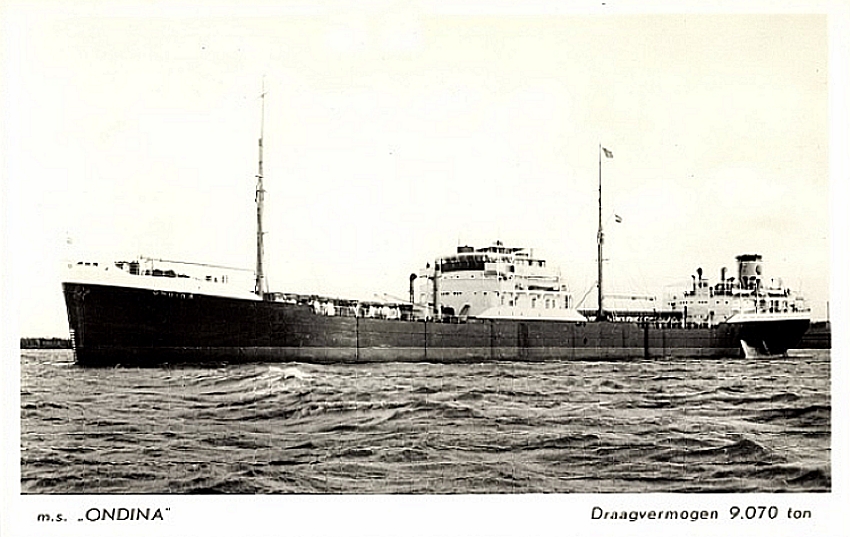
A postcard
of the Royal Dutch Shell tanker M.S. Ondina released just after she was
completed
From the Author’s
private collection
Introduction:
This story came about due to the
M.S. Ondina ships bell which came into my hands many years ago, all the way
from the United
States. As
this page obviously makes it very clear, although this ship was certainly not a
passenger ship, but this bell did come from a very special and what has become
an historic ship indeed with a very special war history, one that is both
significant to the land of my residence and nationality
“Australia”, as well as the land of my birth “The
Netherlands.”
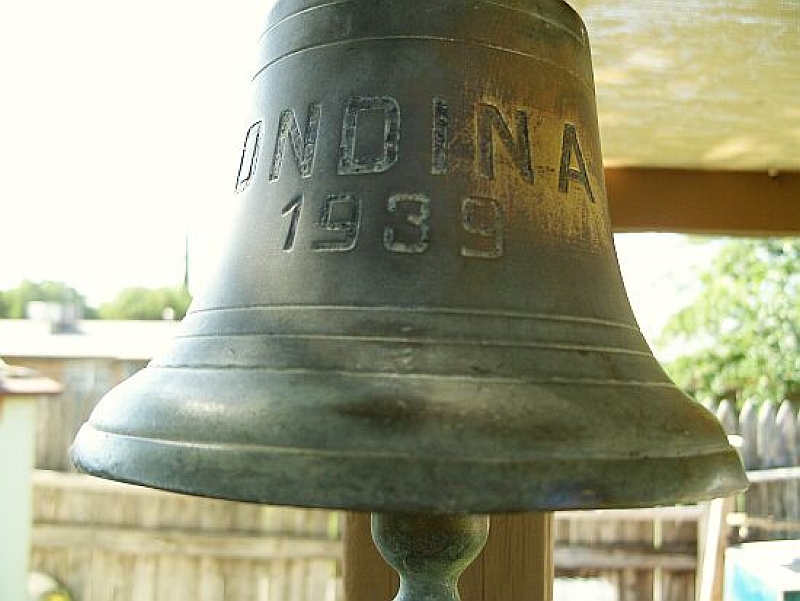
The
ship’s bell
The S.S. Ondina bell is
the property of the author, this image is © copyright Reuben Goossens
This wonderful bell, being a great piece of
history, as you will discover as you read the ships story, is either is
displayed at my own small museum at my home, or it is loaned out to be
displayed at any Maritime
Museum
in Australia
as requested. But let us get to the story of the amazing M.S. Ondina!
As I commence, the details of this story, it was
in part sourced from several sources, but it has been extensively rewritten in
my own words. And as my readers will know, my specialty lies mainly with
Passengers Liners; however, you will find that this amazing heroic tale will
make for interesting reading indeed!
M.S.
Ondina
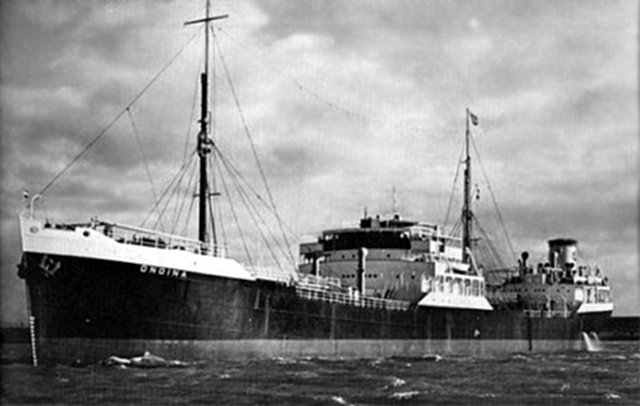
M.S.
Ondina looking her best during peacetime
From the Shell Collection
The brave
Dutch Shell Tanker, M.S. Ondina who fought with several Japanese warships off West
Coast of Australia and although she was outgunned amazingly she ended
up winning the battle!
The “Ondina” was built by the ‘Netherlands
Dry-dock Company. in Amsterdam.
She was officially named and launched on April 29, 1939. Upon completion in
1940 she was managed by one of the group of Shell companies, “La
Corona”, however, with the outbreak of World War II the “Ondina”
was temporally laid up in Curacao.
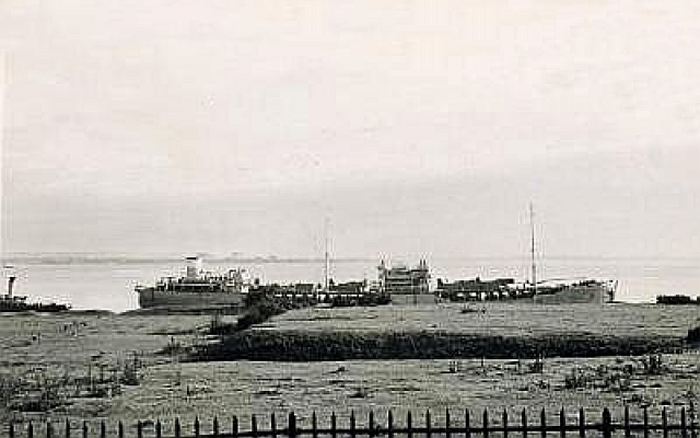
M.S.
Ondina seen laid up in Curacao
Source unknown
M.S. Ondina Specifications - IMO
Nr 5613986.
|
Tonnage
|
9,070-ton
|
|
Builder
|
Nederlandse Dok
& Scheepsbouw
Mij, AM.S.terdam
- Construction Nr 71.
|
|
Dimensions
|
130,49 x 16,62 x 6,40 m.
|
|
Completed
|
August 1,
1939.
|
|
Armament
|
1 x 102 mm USN QF some MG.
|
|
Propulsion
|
One Werkspoor 6-cyl 4-stroke diesel.
|
|
Performance
|
2,800 hp.
|
|
Max. speed
|
12 knots.
|
Activities in the Indian
Ocean:
In late 1942, enemy activities in
the Indian Ocean
had virtually come to an end. The German raiders, once disrupting the shipping
lines in these waters had all (with the exception of a few) been destroyed by
the Royal Navy or had begun the long way home to their homeland in Europe. The
Japanese were strategically not interested in sinking merchants, and had done
little to sink them since their successful sortie to Ceylon
in April 1942. But unknown to the allies, the Japanese Navy had decided to keep
the pressure on the shipping lanes, mostly because of their ever growing
importance in the war. Large and valuable tankers maintained a continuous
stream of oil and other products from the Middle East to Australia
and surrounding islands. The continuous pleas by the Germans will undoubtedly
have had a large influence on this decision, as the Japanese were afraid the
Germans would send more of their successful disguised raiders to the Indian
Ocean, which the Germans considered “their
backyard”. The bond between the Japanese and Germans never grew as strong
as the one between the Allied forces, and they distrusted each other from the
very start of their alliance. To satisfy the Germans, the staff of the Imperial
Japanese Navy decided to send their own raiders to close to the Australian
waters. Although raider warfare was not entirely strange to them, they could
not build on a vast amount of experience such as the Germans had, and as a
result, their ships were far less effective.
The Key Players:
In 1940, two passenger cargo
ships of the Osaka Shipping Line were requisitioned for conversion to Armed
Merchant Cruisers, in anticipation of the likely thrust southward by the
Japanese. The “Aikoku
Maru” and “Hokoku Maru”, which was under
construction for a service between Japan
and South America,
but they commenced their rebuilds in 1941 for war duties, by the time they were
commissioned, they were certainly armed to the teeth. Their specifications are
as listed below:
With their heavy armament, they could
overpower any smaller combatant or merchant, and their speed enabled them (in
combination with their floatplanes) to search large areas of ocean. In service,
they were organized with “Kiyozumi Maru” in the 24th Special
Cruiser Squadron under Rear-Admiral Moriyoshi Takeda.
Even though these ships were slightly more powerful than their German counterparts,
they were less effective for several reasons. First, the Japanese had little
experience in operating surface raiders, and it seemed to them that letting
these ships operate in a pairs reduced the risk of losing them. Second, the
ships spent far less days at sea. They had played a modest role since December
1941, and their first contribution to the war effort came when they overpowered
the American freighter “Vincent”
on December 12 1941, this was soon followed by the loss of “Malama”. Their last operations were by far the most
successful: they acted as supply ships for the Japanese submarines operating in
Mozambique Channel.
These I-boats sank over 100.000 tons of shipping, and the “Hokoku Maru” and “Aikoku Maru” added a number of additional
ships to their score. With the successes they had, and sunk or
captured 5 merchant ships within a year, totalling 31.303 tons. They left Singapore
on November 5 on their fourth sortie, under overall command of Captain “Imazato Hiroshi”.
The M.S. Ondina:
The “Ondina” was a
modern tanker built for one of the shipping companies of Shell’s, ‘La
Corona’ Co. She was new, relatively fast and for contemporary standards she
was lightly armed, with a 4 inch gun on her stern and several machine guns for
AA-use. Under Captain “W.
Horsman”, she was now
deployed on a line between Fremantle in Australia
and Abadan on
the oil-rich shores of the Persian
Gulf. On her journey to Abadan,
she would be escorted and under the protection of the 650-ton corvette “HMIS
Bengal”, which was under the command of “Lt.
Cdr. W.J. Wilson,
RNR”. The vessel was one of the Royal
Australian Navy-type Bathurst Class corvettes and she and her three sister
ships had all been allocated temporarily to the Indian Navy, but with an all
Australian crew. She only had one 3-inch gun instead the 4-inch gun which sadly
was not available at that time, which made her firepower certainly not enough
to protect the “Ondina” from submarines, let alone from enemy
surface raiders or from the air.
The two ships departed Fremantle on November
4, 1942, expecting a long but uneventful trip.
The “Ondina” had additional
supplies of fuel oil onboard, which was to refuel the “Bengal” at Diego
Garcia before the tanker then
proceeded to Abadan
in the Persian Gulf and the corvette was to leave for Colombo.
The “Bengal” was in fact the fourth and last of the ‘Bathurst
Class’ corvettes built in Australia
for the Indian Navy. And with the “Bengal”
only recently having completed her commissioning trials, she was certainly all
very new at her job, but sadly her crew were not well trained!
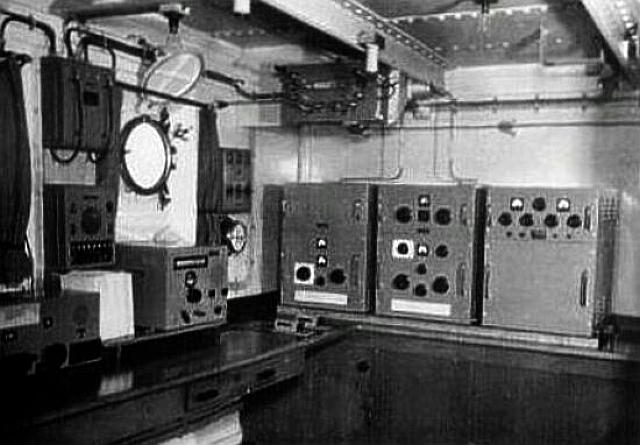
“Ondina’s” radio room
From the Shell Collection
The Great and Famed Battle at Sea:
On November 11, 1942, at 11.45 AM
the naval authorities in Fremantle received a SOS-signal sent out by the “Bengal”,
reporting that she and the “Ondina” were under attack by two enemy
raiders, identified as being Japanese, in position 19.38 N - 93.5 E. The battle
started when a lookout onboard “Ondina” sighted an unknown vessel
at about 12,000 metres away, bearing 270 degrees, followed by ship of similar
size. As no allied ships were reported in the vicinity, they could only assume
they were hostile and for some time these ships were even identified as
Japanese carriers. On the “Bengal”,
the lookouts saw the two AMC's a few minutes later.
The ships both made a quick 90 degrees turn to starboard away from the enemy to
a north-north-west direction. “Bengal”
then turned and headed straight for the enemy, hoping to buy enough time for
the “Ondina” to escape. She opened fire at 1200 hours from 3200
metres away, soon followed by the “Ondina” at 1205 PM some 8,000
metres away. The sensible thing to do for the “Ondina” was to
follow the order to escape, but the captain decided to stay, as his ship, armed
with a 4-inch gun and being the most powerful of the two ships. In addition,
the “Ondina” could only do 12 knots versus 21 knots of the Japanese
ships.
The “Aikoku Maru” with Captain “Oishi
Tamotsu” in charge, and the “Hokoku Maru” with Captain “Imazato
Hiroshi”, they commenced firing at 1200 hours, and soon straddled the “Ondina”
with their cruiser-armament. The first hit on Ondina ripped off a part of the
main mast, leaving only a stump standing.
The “Ondina” herself had her
answer ready: the third shell fired by “Ondina” was a direct hit in
the superstructure of the
“Hokoku Maru”, but apparently it
did little to affect her speed or armament. Content with the hit, the gun
captain then ordered the gunners to concentrate their fire on the stern. Only a
few moments later, a lucky hit on the starboard torpedo mount turned the “Hokoku Maru” in a ball of red and
yellow flames, and as the ship emerged from the smoke, she was listing heavily
to starboard, and simultaneously started to settle by the stern. The explosion
ripped off the stern and threw her two floatplanes overboard, while massive
fires raged in the superstructure. Of
course the “Hokoku Maru” was not built as a
warship, and therefore she did not have a sufficient number of watertight
bulkheads. Shells fell from their lockers as a result of the increasing list
and threw sailors overboard. Men, covered with burns and blood tried to fight
the flames. Reports came in indicating large fires in the engine room and the
loss of all electricity. There was little hope of salvaging the “Hokoku Maru”, and Captain
“Imazato”
could do little else than to order “abandon ship!”
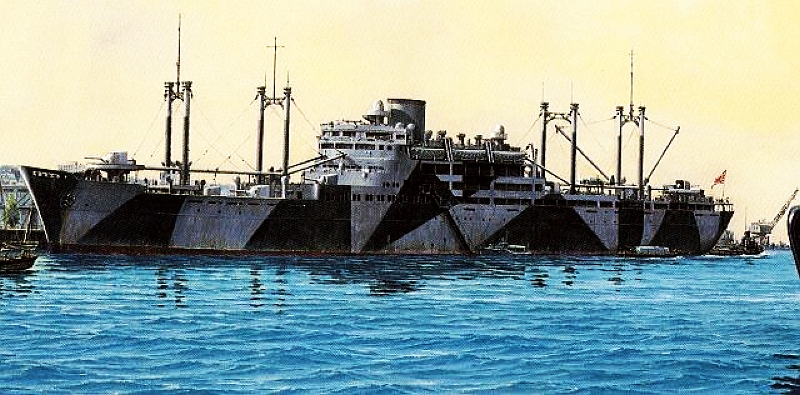
A
painting of the Imperial Japanese Navy Ship “Hokoku
Maru”
From one
of the sites credited at the bottom
of the page
The “Aikoku Maru” soon avenged her
sister ship, scoring several hits on Ondina. Fortunately, shells and torpedoes
have little effect on empty tankers, as the large number of watertight tanks
keeps them afloat under the most difficult circumstances. “Aikoku Maru” also fired at the “Bengal”,
which had shortened the distance to about 2200 metres. One shell from the
Japanese hit her in the forecastle, luckily doing little damage. Her gunners
had been firing continuously at the Japanese, claiming several hits.
Unfortunately, the ammo supply was soon depleted. At 1245, her
last shell had been fired and her captain decided there was little he could do
for the “Ondina”. He steamed away at full speed, chased by gun
splashes. After laying a smokescreen, she took a hit in the stern which did
little to hamper her escape. Last the men aboard “Bengal”
saw was the “Ondina” was also trying to evade the shells,
continuously straddled by the “Aikoku Maru”. A shell was seen
hitting her abaft the bridge. Some time later, a second explosion was seen
aboard the “Hokoku Maru”, still burning and
sinking. After leaving the scene, “Bengal”
set course for Diego
Garcia, where the captain
reported the “Ondina” and one enemy AMC
had sunk.
“Bengal’s” captain was right
about one thing, the “Hokoku Maru” had indeed sunk, but
after the “Bengal”
had disappeared behind the horizon, whist the M.S. Ondina was still steaming
around at full speed. Not built as a warship, she had only a small ammo supply.
The “Aikoku Maru” then closed the range
to 3500 metres, and placed several hits in the following minutes, one of which
was observed by the “Bengal”.
The “Ondina” herself had only 12 shells left, four of which she
fired at the “Hokoku Maru”,
the rest at “Aikoku Maru”,
apparently without placing a hit. A last attempt to escape by dumping smoke
buoys overboard was unsuccessful, and the captain ordered the crew to abandon
ship to avoid further bloodshed. The engines were stopped, the lifeboats
lowered and a white flag was hoisted, all under continuous fire from the “Aikoku Maru”. A few moments later,
Captain ‘Horsman’
was killed by a piece of shrapnel from a shell hitting the bridge. Two
lifeboats and two rafts were lowered into the water and later, another lifeboat
was in the water with the remainder of the crew. Most of the crew (with the
exception of officers and gun crew) consisted of Chinese, and they had been
troublesome during the whole action, refusing any assistance that might help
save the ship.
Then the “Aikoku Maru”
approached the “Ondina” to about 400 metres, and fired two
torpedoes to finish the ship off. Both slammed big holes in the starboard side
bow, but did little to sink the ship itself. These tanks had been empty and the
ship remained afloat on the other, undamaged fuel tanks, despite the 30 or 35
degrees list. Then “Aikoku Maru” changed course and
the Japanese gunners opened fire on the drifting lifeboat. One
sailor was killed, with three others heavily wounded. One of them was a young
British sailor named Henry,
originally assigned to the “Bengal”.
Satisfied with the results, “Aikoku Maru” then steamed away in order to pick up survivors from “Hokoku Maru”.
Later, the “Aikoku Maru” came back one more
time, firing a torpedo which missed the tanker. She paid little attention to
the survivors and steamed further; convinced the “Ondina” was doomed.
Meanwhile, the men in the lifeboats had given
the deceased a seaman’s burial, and then exchanged thoughts about what to
do next. The first officer ‘Rehwinkel’
wanted to return to the tanker, but only one man of the gun crew was willing to
go with him. Most of the others were convinced the “Ondina” was
about to go down. Not without trouble, ‘Rehwinkel’
managed to assemble a small number of men and returned to the ship, where
counter flooding reduced the list. Inspection revealed that her engines were still
intact. The small fires were extinguished and the last crewmembers in the
lifeboats were taken aboard, after the latter were convinced that there was no
danger of sinking.
Now came the long leg
back to Fremantle. The lifeboats were patched up as good as possible, in case
the “Aikoku Maru” came back. The
British sailor Henry was in a poor shape.
He had a crushed leg and after two days the first officer was forced to send
out an un-coded signal for help. It could not be coded as the codebooks had all
been thrown overboard when “abandon ship had been ordered. This
unexpected signal caused a shock in Colombo,
for all they knew that the “Ondina” had sunk and logically, the British
thought the Japanese were playing a trick on them. A signal went out from
Fremantle to report her position. Expecting a trap by the Japanese, the “Ondina”
did not reply. Without medical attention the “Ondina” headed
towards Fremantle, and six days later, on the 17th an Australian flying boat “Catalina”
was sighted, about 200 miles northwest of Fremantle. The lookouts had reported
a ship some time earlier, and the “Catalina”
was asked if that ship could provide the much needed help. The unknown ship
proved to be a hospital ship being the Australian luxury passenger liner,
currently in use as a Hospital Ship, A.H.S.
Wanganella. All the wounded were transferred to the Wanganella where doctors
immediately began a series of blood transfusions to save Henry’s life,
and did so with great success.
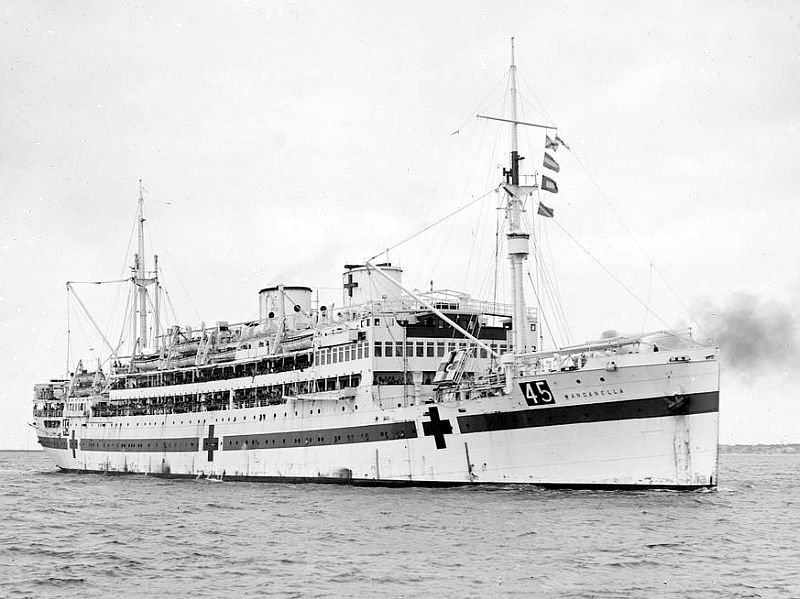
Australian
Hospital
Ship - A.H.S. Wanganella seen at full speed ahead
From the
author’s private collection
On November 18, both the “Ondina”
and the “Wanganella” entered Fremantle after a journey only a few
ships had experienced, let alone lived to tell about it. The corvette “Bengal”
had entered Diego
Garcia the day before. The “Ondina”
received emergency repairs and she remained in Australia
for some time.
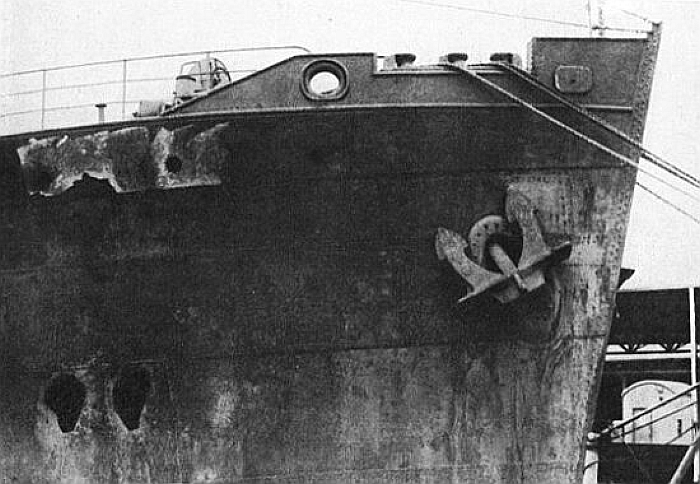
Some
of the damage done by the “Hokoku Maru” can be clearly seen
on “Ondina’s” bow
Photographer unknown
- *Please see the Photo Notes at re bottom of the page!
In order to supply the Potshot
base with marine fuel oil, marine distillate and aviation fuel, four a
2,000-ton welded steel tanks were being constructed at the port
of “Onslow”
(today’s “Exmouth”). The tank would hold distillate for
submarines in service mid 1943. After the Indian
Ocean ordeal she served at Potshot
marine depot as a temporary floating storage facility until the “Onslow” tanks was finally completed around October
1943. Thereafter, the US Navy provided a 500-ton barge to collect the
distillate from tankers and pump it ashore into the newly completed shore tanks
at Potshot.
For interest, “Potshot”
was the codename for the spartan base and rest camp
for submariners using the tender U.S.S. Pelias and an airfield was constructed there to provide
fighter defence for the base. “Z Special Unit” used Potshot as a staging base for “Operation Jaywick” in September 1943. Today this small marine
base is the Western
Australian
Town
of Exmouth with a population of around 2,400. However, it is also a popular
tourist center, but so far removed from major capitals, even from Perth the
capital of Western Australia is 1,270 kilometres - 789 miles away, or
Darwin in the Northern Territory is a mere 3,366 kilometres - 2,092 miles
and that is the nearest neighbour state capital. Or from Brisbane
the capital of Queensland
the distance is 5,778.45 kilometres – 3,590.41 miles.
In due course the “Ondina”
was fully repaired and both the H.M.I.S Bengal and M.S.
Ondina continued in their respective services. However, I should
mention that even before she went to Potshot, the “Ondina”
supplied fuel and water to the SRD vessel “Krait”
that was heading for Singapore
where she carried out a most successful attack on Japanese shipping. The refuelling
occurred on September 1, 1943. Of course the “Krait” has become
folklore and most famous!
By the end of 1943 oil tankers were obviously
in short supply and thus it had been decided to have the “Ondina”
sail to the United
States to
undergo major repairs. However she first headed for Melbourne
as work needed to be done to strengthen her hull sufficiently for the voyage
across the South Pacific. On board there was a crew of Dutch officers and a
Chinese crew. But, just as the ship was about to depart Melbourne,
all but two of the Chinese crew deserted ship. Shell decided to continue the
voyage and have two of the DEM.S. gunners
acting as helmsmen whilst the other six men would keep their watches on the
guns. The ninety four day voyage was long and it seemed to be everlasting to
all on board, as the headed for the Panama
Canal. But once they had cleared the Canal she headed
for Galveston
where the repairs were to take place, however, a new order had arrived and they
had to continue to Tampa
Florida.
There she received a full restoration as well as a considerable refit improving
all her crew quarters!
The M.S. Ondina was still operational in the
late 1950s and she returned to Fremantle around 1956, which sadly was rather
unnoticed by most!
Aftermath:
Very few questions remain
concerning this clash, but the most important one is who fired the fatal shot?
Answering this question is difficult only because as both the “Ondina”
and “Bengal”
claimed to have scored the fatal hit. It was the Japanese themselves have stated
that it was without a doubt the “Ondina”. According to them, her
shell hit the starboard torpedo launcher, causing the torpedos
to explode. At the time, the “Bengal” was given the benefit of the
doubt, according to the author from one of my sources as an attempt to use this
battle for propaganda in India,
where the British had a lot of trouble keeping the people under control.
However, the gun on the “Bengal”
was not able to do enough damage to the Japanese ship, and yet somehow the
Australian Navy already knew this!
In retrospect, this battle was not only was a
tactical success for the Allies, but it also offered implications for future
strategies. The loss of the “Hokoku Maru” led to the abandoning
of raider warfare by the Imperial Japanese Navy and never (with one exception) tried
to break the lifeline again.
M.S. Ondina was given a rare Dutch
distinction, the “Koninklijke
Vermelding
by Dagorder”, issued on July 9, 1948. Captain
W. Horsman
who became a Ridder (Knight of the) “Militaire Williems Order” der 4de Klasse posthumously and was Mentioned
in all Dispatches. This order was the oldest and highest honour of the Kingdom
of the Netherlands.
2nd.Officer Bartele Broer Bakker:
I wish to thank Mr. Tom Bakker
of the Netherlands
for contacting me, as he provided me with another part of M.S. Ondina story,
and that is the story regarding his dear late Father Mr. Bartele
Broer Bakker who was a
Lieutenant in the Koninklijke Marine (Royal Marines) and he was placed on board
the “Ondina” as the ships 2nd.Officer
during World War Two.
Tom Bakker’s
email told me the following in part;
“Dear Mr
Goossens, I have read your story
about the Ondina with a lot of interest! My father, Bartele Broer Bakker was 2nd.Officer on the Ondina when it was attacked by
the Japanese raiders on 11-11-42. So I know the story very well.”
He provided me with a link that gave me some
further detail in Dutch, which I had translated and I am delighted to add the
story of his dear Father and the story of his obvious heroism to this page, for
he was highly awarded as he received the Netherlands
highest honour of becoming a “Ridder”, being the Dutch version of a
“Knight!”
Bartele Broer
Bakker (Ijsbrechtum March 13, 1918 - Nijefurd May 16, 1988). During
World War 2 and
he was the 2nd.Officer on Board the M.S. Ondina.
Awards
given:
1… “Military Williems Order”
- (MWO.4), granted on August 28, 1948
2… “Distinguished Service
Cross” - (DSC).
3… “Honourable Mention”
- (EV).
4… “War Memorial Cross” (OMK).
Awards 2 to 4 were officially awarded on
January 14, 1943, together with another
award, the “Bronze Cross”
- (BK), however, this award was repealed and
replaced with a far greater honour of the “Military William
Order” in August 1948.
“Military Williems Order” - MWO, which is the highest award that can be
awarded, for it is the equivalent to a Knighthood. It is explained in Dutch as;
“Ridder der Militaire
Williems Orde” or “Knight
of the Military Williems Order.”
The reason the “Knight of the Military
Williams Order” was awarded, as was stated as follows;
“During
a battle that was distinguished by excellent acts of courage, selfishness and
faith by the 2nd.Officer of the M.S.
Ondina, which was only fitted with a 10.2 cm cannon and on November 11, 1942
whilst in the north of the Indian Ocean together with the accompanying Royal
Indian Navy Minesweeper, having received permission of his commander, under
dangerous conditions he entered into a conflict with two powerful fully armed
Japanese Auxiliary Cruisers,” being the ‘Hokoku Maru’
and the ‘Aikoku Maru.’ And as we have read, it was an
amazing fight that too place!
There was an official presentation of the “Military William
Order” on
October 7, 1948 that took place on the Sonsbeek meadow in the City of Arnhem. Thus as we can see, this
brave man was a highly decorated ships Officer with countless awards that were
given to him for his service to his country as well as Australia!
It should be noted that the “Distinguished
Service Cross” was given
to Lieutenant Bartele Broer Bakker by the British for the
following reasons;
“Great
gallantry when the vessel, escorted by only one destroyer was attacked by two
enemy raiders, one of which she sank. Although her crew was forced to abandon
ship during the action, she was re boarded and was brought safely to port.”
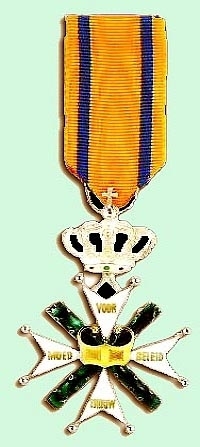 ----
---- ---
---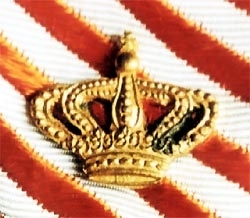 ---
---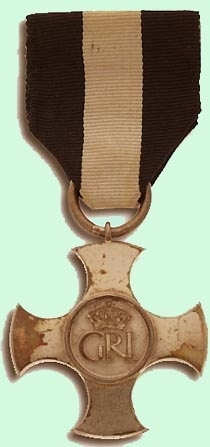
Left
to right: “Military Williem Order” -
“War Memorial Cross” - “Honourable Mention” - “Distinguished Service Cross” (United
Kingdom).
Other Awards Handed Out:
In addition Australian Able
Bodied Seaman ‘Bertram Albert George Hammond. RAN (Royal Australian Navy) service number: PA1318,
received the Distinguished Service Medal and the Bronzen Kruis (Bronze Cross) on May 22nd, 1943. However, this medal was replaced by a
much higher honour, being “The Netherland’s
Bronze Lion” with an “Honourable Mention.” The captain of the
Bengal,
Lieutenant-Commander Wilson, received the Distinguished Service Order, while
others of his crew were also awarded.
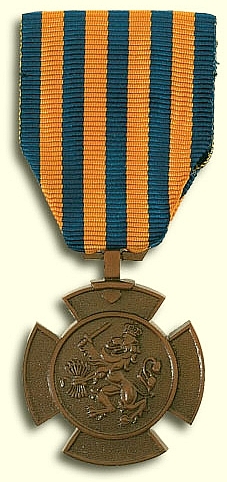
This
is the Bronze Lion Medal, a high honour to an Australia Naval man indeed!
With thanks to: www.ww2awards.com for their excellent information
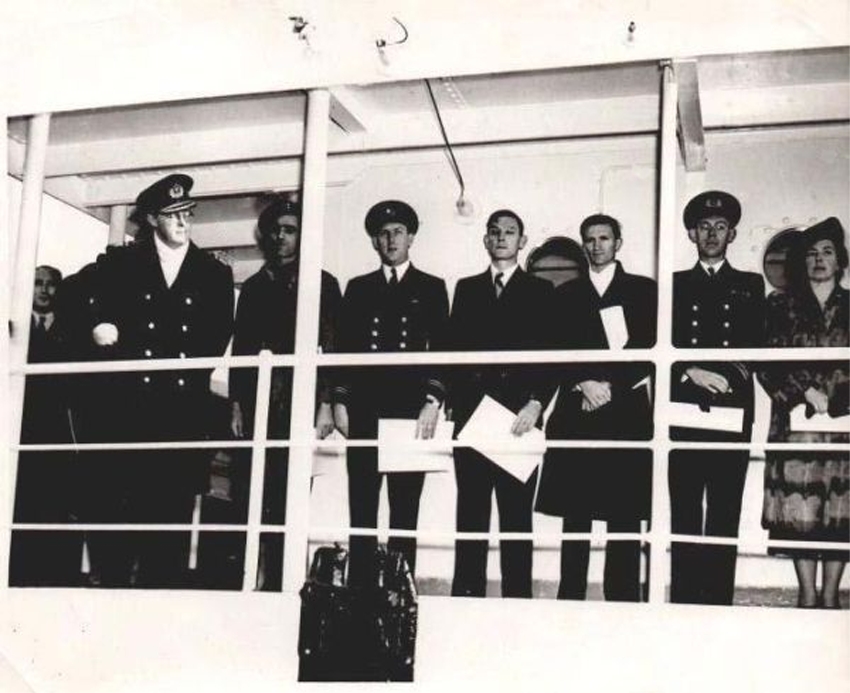
Here
we see a Bronze Cross Medal presentation ceremony attended by H.R.H. Prince Bernhard of the Netherlands
(left)
Who
is seen with a number of recipients. I will add
details as soon as I obtain them!
Photographer unknown
- *Please see the Photo Notes at re bottom of the page!
Lance Bombardier F.
Ryan. No.
4192090. MRA:
Recently I received an email from Mr.
Colin Jarry-Ryan in the United
Kingdom, and
he kindly provided the following interesting information regarding his Uncle.
It reads as follows:
“…
my Uncle, Patrick
Francis-Ryan was on board as a
gunner and (was) decorated by the Dutch Government with the Bronze Cross for
his part in this battle. Please find attached his photo and (one of) the medal.”
Please Note: The words in (brackets) were added by the author.
This was followed up by another email from the
son of Patrick
Francis-Ryan and he advised me as
follows”
“My
name is Tony Ryan,
and Patrick
Francis Ryan
was my father, who sadly deceased 20 years ago. He was known as Frank
Ryan while he was in the
forces, and he was presented with his medal either on November 7 or the 8th.1948 as I have entry and exit stamps for Holland
in his passport for those dates.”
Very soon there will be additional images
added, such as two British Newspaper clippings and the official Dutch Citation
from H.R.H. Queen Wilhelmina
of the Netherlands,
but presented by Prince Bernhard, husband of Princess
Juliana, the future Queen.
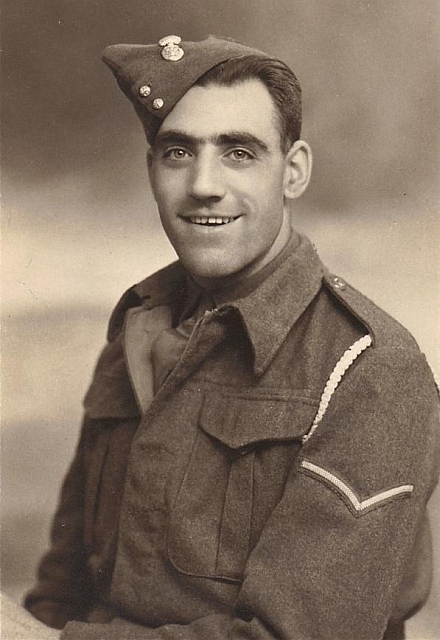 …..
…..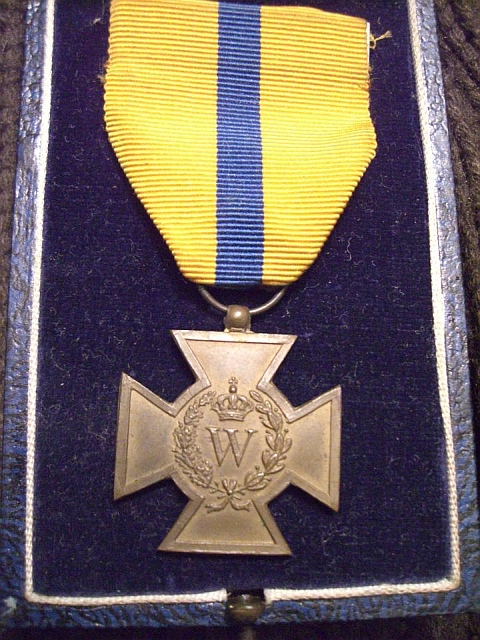
Gunner
Frank Ryan
and his Dutch “Bronzen Kruis” (Bronze Cross)
received for his bravery whilst in battle!
Provided by Colin
Jarry-Ryan
I hereby wish to thank Mr.
Colin Jarry-Ryan and
for providing the information regarding his Uncles involvement as well
as sending the relevant photographs. I am sure that the many readers of this
page will greatly appreciate it!
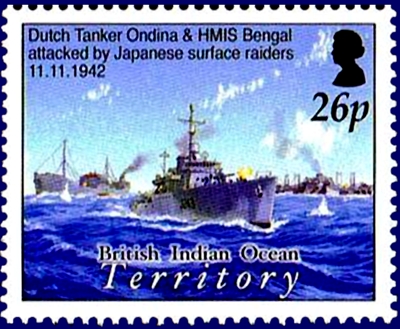
This
is a commemoration stamp issued
Australia in those days was still
called British, the “British Indian Ocean” Today it is no longer
so!
Australia is an Independent, but
part of the Commonwealth, and has its own National Anthem
From the author’s private
collection
******************************************
Sister Ships and the Final days of the M.S.
Ondina:
M.S. Ondina had quite an
extensive fleet of sister ships such as the: Elusa, Ena, Erinna, Etrema,
Eulota, Ocana, Olivia, Omala, Onoba, Oscilla,
Ovula And Anglo Saxon Owned Elona,
Ensis, Erodona, Eulima, Mactra, Opalia, Otina, Ovatella, Pellicula, Sepia, Simnia, Sitala, Solarium, Standella, and the Tricula.
After the World War II, M.S. Ondina sailed on
sailing on a good number of services, but in due course having had a busy and
certainly a tumultuous twenty year career, she was finally sold in 1959 to be
broken up in Hong Kong.

Here
we see the Ondina in her later years
From the
Shell Collection
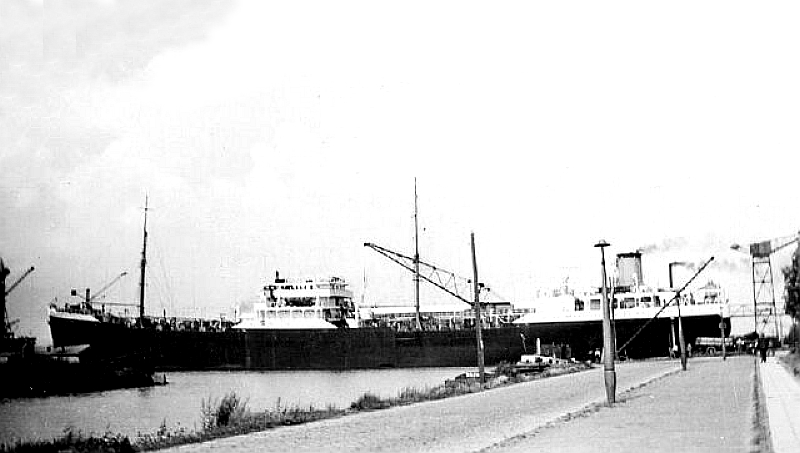
The
Ondina is seen here laid up just before heading for the breakers yards in Hong
Kong in 1959
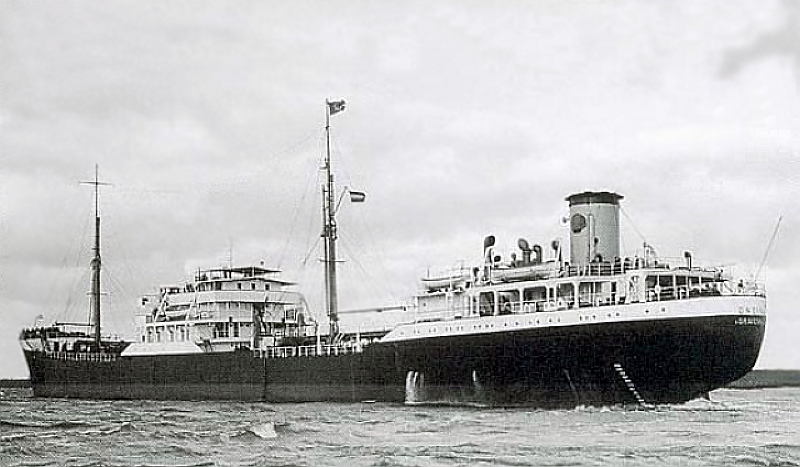
M.S.
Ondina departing and she is bound
for Hong Kong,
where she will be broken up
From the Shell Collection
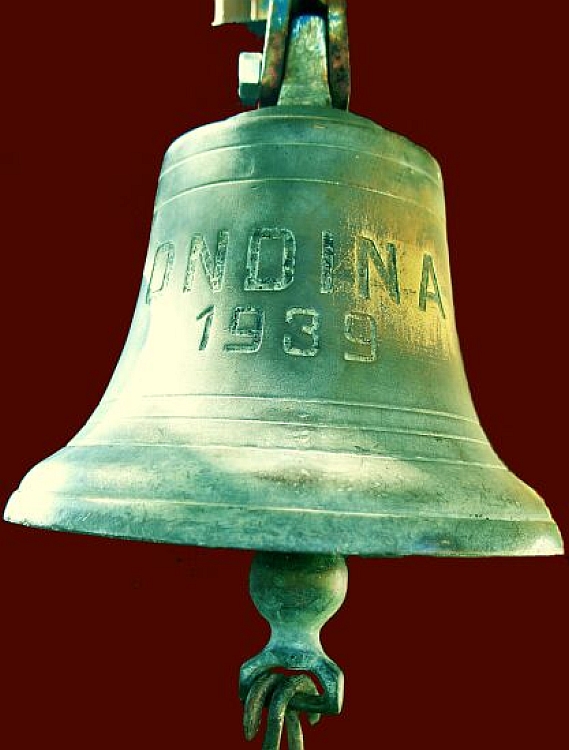
M.S.
Ondina’s ships bell
currently on show at my home - it is available to Maritime Museums.
The bell is
part of the author’s private collection and the property of the author.
This image is © copyright - Reuben
Goossens
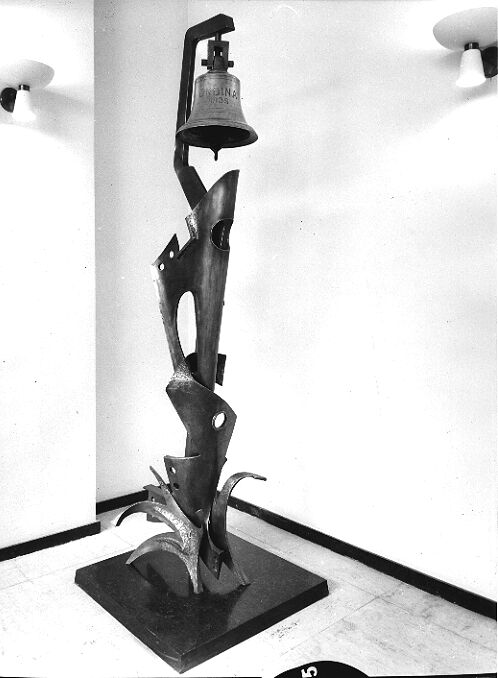
This
is another “Ondina” bell from her bow, seen in the Lobby of the Royal
Dutch
Shell
Building
in Amsterdam
From the Shell Collection
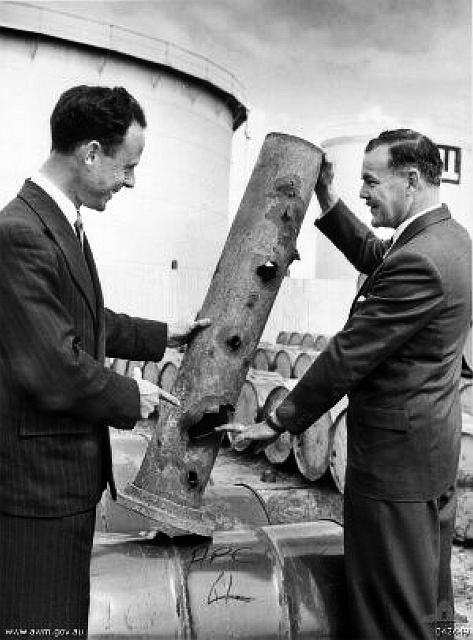
Re
Photograph Above: Mr D Erskine (right) and Mr J
Browning of the Shell Oil Company inspect the bullet riddled mast of the
Company's tanker Ondina which was found in a North Fremantle boilermaker's
yard. On 1942-11-11 the tanker, escorted by a minesweeper, was attacked by the
Japanese raider Kokoku Maru about 1400 miles from
Fremantle and with her one gun she sank the raider. A second Japanese raider,
the Kunta
Maru,
appeared and blasted the escort into a hulk. The Ondina fought until her last
round was fired and then the Captain stopped engines and ordered "Abandon
Ship". Ignoring this, the raider continued shelling the vessel and finally
torpedoed her. After the raider left the scene the tanker's surviving crew
members boarded Ondina, extinguished the fires, righted her list and sailed her
back to Fremantle. Six of her crew were decorated - including Captain
W Horsman,
posthumously. Photograph: “Australian War Memorial, Copyright expired
– Public domain.”
My personal story
with the Ondina:
This story takes place in Rotterdam,
the Netherlands
in 1953.
My Mother who had many friends all over the
world, had a very good friend who happened to be a Captain of this Shell tanker
the “Ondina”, and when she was in port in Rotterdam
my Mother and I were invited to come on board one afternoon. Unknown to me at
the time was that the ship was still awaiting a berth and she was at anchor,
thus the Captain, whose name I obviously have forgotten, had a lifeboat waiting
for us, and off we went. It was great fun! We boarded by what seemed like a
never ending staircase that moved, as I had not experienced this before! Once
on board, I noticed the smell of oil and the vast decks with its countless
long, long pipes. There was an aft deck house with a mostly Asian crew, and the
amidships deckhouse for the Dutch officers, which was very nice indeed. I was
taken up to the bridge for a look, which seemed rather small for such a large
ship, well I thought it was large, as I was still young I had been on the
Bridge of the R.M.S. Queen Mary and that was Huge! We
then went to the Captain’s quarters which being quite fancy compared to
the other areas I had seen, as he had several rooms such as a bedroom, lounge a
dinning area and a spacious office. I was surprised as it was almost as good as
the Queen Mary’s
Captains quarters. We sat down in his lounge and were offered coffee and
something to eat, being served by an excellent Indonesian Steward, and
alcoholic drinks were poured for the adults, such as my mother, the captain and
officers present.
We had a wonderful time on this ship, as I had
only been on Passenger Liners in the past, but I did not know the name of this
ship, so I asked the captain for her name and he said; “Reuben this a
well known ship that became very famous during the War, for she is the “Ondina”.
One day you will learn all about her for she was far away on the other side of
the world in Australia
and fighting Japanese warships and she was badly hit by these ships, but she
fought back and she eventually won sinking one of their warships, even though
she was badly damaged, she was able to limp back to port and she was repaired!
Thus as you can see I have been on board the M.S.
Ondina and somehow I ended up have a small connection to her, and through a
miracle someone contacted me one day and stated that “as was crew member
on the Ondina and I have one of the three ships bell’s and I would like
to give it to you as you have honoured the “Ondina” with your
ssmaritime feature of the ship I have served on for so long”. Thus, it
seems that somehow it was meant to be that one of her Bell’s
would end up with me! As a child, I stood on her bridge, sat in her Captains
quarters. Told me her story, which I duly forgot, but in my latter years I
revived it online, and someone read it and rewarded me with her bell! Just
amazing!
Sources to the main story:
K.W.L.
Bezemer:
"Verdreven doch niet verslagen"
Eiichi
Nakajima: “Hokoku
Maru”
- the unknown Q-ship (an extract was kindly provided by Sander Kingsepp)
Warship International No 4, 1994
Thanks to Roel Zwama, Anne
Niemantsverdriet, Bert
Kossen, Jean-François
Masson, Dan
Muir and Ferry van Eewen for the additional details.
And also thank you - dutcheastindies/Ondina
& AWM - www.awm.gov.au.
Remembering
the Brave M.S. Ondina!
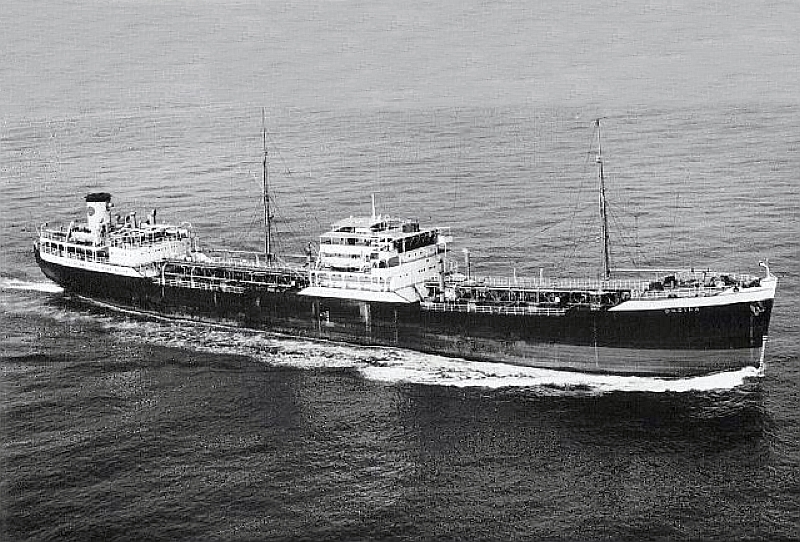
The
Ondina at sea in her earlier days, it is a great way to remember this brave
ship!
From the authors private
collection
View a special Painting
of the Shell-tanker Ondina” Exhibition!
This
is available on its own special page - CLICK HERE
***********************************
“Blue Water Liners sailing to the distant shores.
I watched them come, I watched them go and I watched them
die.”
Return to the ssMaritime MAIN INDEX
ssMaritime.com
Where you will discover over 1,750 Classic
Liners.
The
Author has been in Passenger Shipping & the Cruise Industry for over 60
years!
Please Note:
ssmaritime and associated sites are 100% non-commercial and the author seeks no
funding or favours of any shape or form, never have and never will!
Photographs on ssmaritime and associate
pages are by; the
author or from the author’s private collection. In addition there are
some images that have been provided by Shipping Companies and private
photographers or collectors. Credit is given to all contributors. However,
there are some photographs provided to me without details regarding the
photographer/owner concerned. I hereby invite if owners of these images would
be so kind to make them-selves known to me (my email address may be found on www.ssmaritime.com only),
in order that due credit may be given.
This notice covers all pages; although, and I have done my best to ensure that all
photographs are duly credited and that this notice is displaced on each page,
that is, when a page is updated!
ssMaritime is owned & © Copyright by Reuben Goossens - All Rights Reserved








 ----
---- ---
--- ---
---


 …..
…..








